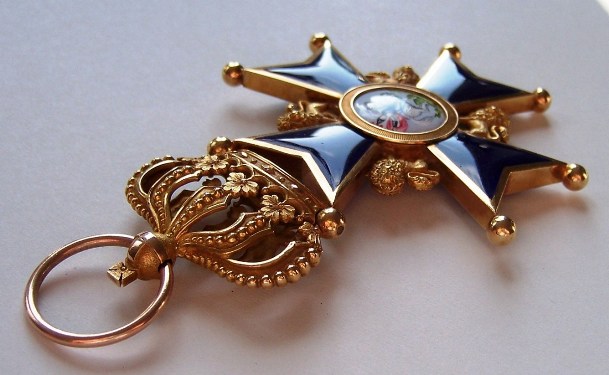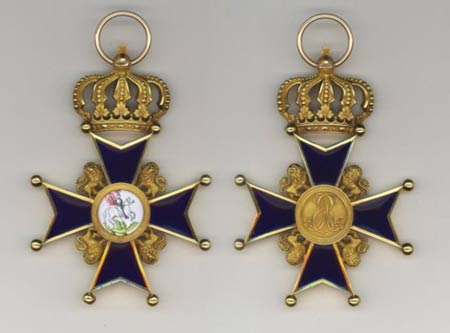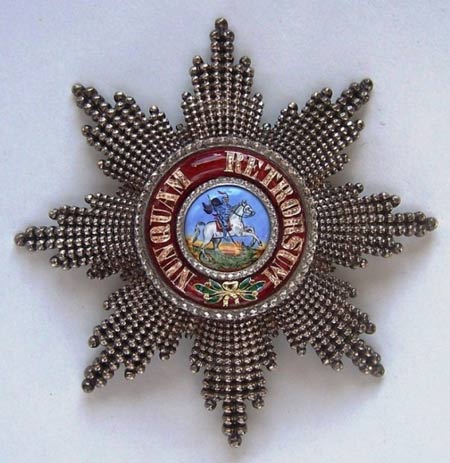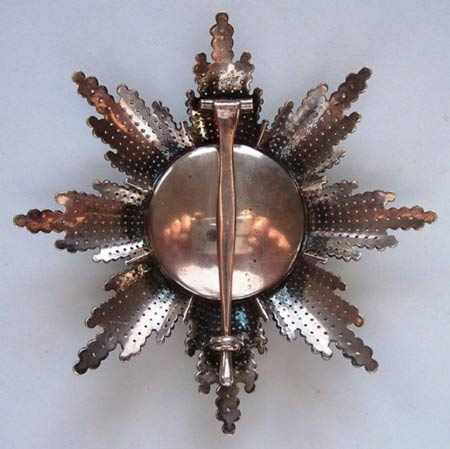|
From
1814, when Hanover became a kingdom, the British monarch was
also King of Hanover. In 1837, however, the personal union of
the thrones of the United Kingdom and Hanover ended. Not
having access to the highest British Order, the Order of the
Garter, Ernst August, king of Hanover, founded on
April 23, 1837 the order of St. George as his own house order.
Being used to the ways of the prestigious order of the garter
the newly founded St. Georg’s order was brought to life with
a very similar set of rules. Following a few from the original
statues:
§
3 - the order had only one class and the recipients were
called knights
§
5 - the circle of members was limited to only 16 for
Hanoverians besides the princes of the House of Hanover.
§
6 - the order can only be awarded by the King of Hanover
§
8 - besides princely kin one had to be at least 30 to be
accepted into the order.

The
St. Georg Cross
The
order consisted as a matter of fact of only princely members
for all of it's lifespan. From 1837 to 1866 only 78 knights were created.
Almost all were head of states with the exception of the
Hanoverian minister of state von Alten, the Prussian minister
of state prince Sayn-Wittgenstein, the Austrian minister
Prince Metternich, Austrian field marshals count von Radetzky
and prince Windisch-Grätz as well as the prince von Bentheim.
With decree of September 20, 1866, and the lost war, Prussia
allowed all recipients of Hanoverian orders to carry on wearing
them going forward. Since all recipients were of princely
descent it needs to be seen whether anybody was really touched
by this gesture. In fact four additional knights were bestowed
after the lost war.
Naturally
almost none of the awarded decorations were returned after the
death of a recipient to the Hanoverian orders chancellery. We
know that the British order collection still has examples of
this rare order and a handful of other museums.
Being
awarded only into the wealthiest and most renowned families few decorations are publicly known. Among the recipients
of the order are for example: Zar Alexander II. of Russia
(1840), King Maximilian II. of Bavaria (1847), King Frederik
VII. of Denmark (1851), King Leopold I. of Belgium (1853),
Emperor Napoleon III. of France (1860) and Zar Alexander III.
of Russia (1865), to just name a few. The book:"Orden u.
Ehrenzeichen des Königreiches Hannover" published in
1981 lists all recipients.

A
1850th St. Georg Cross (Avers and Revers)

A
1850th St. Georg Star (Avers)

A
1850th St. Georg Star (Revers)
Only
three official manufacturers are known. The very first one and
best of his class was nobody else but the firm of Johann
George Hossauer, who supplied the first 12 sets for 85 "Reichstaler"
and 5 "Mariengroschen". He also manufactured the
collar chain for the grand master of the order. Carl Zell in
Hanover, court jeweler since 1841, offered the set at a
discount of roughly 11 "Reichstalern". Carl Büsch,
court jeweler since 1863, must have supplied the decorations since 1860.
© A. Schulze Ising, XII/2012
| 




